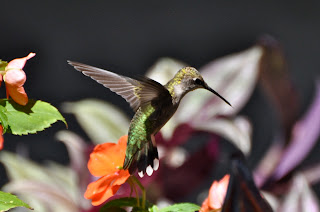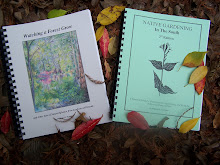eastern coralbean (aka "mamou plant") in bloom
As a follow-up to the previous post regarding the Louisiana hummingbird phenomenon, here's a little primer regarding best nectar plants for hummingbird garden use. Due to space limitations, I'm focusing on only the best/most essential hummer plants for our region. Here along the Gulf Rim, “our region” includes horticultural planting zones 8b-9 (google “U.S. horticultural zones, if you're not familiar).
The Major Players
First and foremost is Tropical Sage (Salvia coccinea), native to the immediate Gulf Coast and southern Atlantic Coast from Texas eastward through South Carolina, where it resides in coastal forests, often in association with coast live oaks (Quercus virginiana). In garden settings, tropical sage often verges on weediness; but that's precisely what hummingbird/butterfly gardeners need. And ultimately, it is so shallow-rooted that pulling it up is a snap.
this pink-flowered form of tropical sage popped up in our garden
from a nominate red-flowered plant that we obtained from
cheniere au tigre on the central louisiana coast...over the years
it has actually out-competed the nominate form in places........
This species grows 12-60” depending on sunlight exposure, soil type, soil moisture, genetic strain, etc. The cool thing about it is that you can maintain it at any height you want. I've seen it maintained as a ground cover beneath live oaks; kept at 4-6” via weedeater, and happily blooming away. As with most all New World salvias, the more you deadhead (prune off the spent bloom spikes) the more they bloom. Tropical sage is happy in just about any sunlight regime, from full sun to rather deep shade; and most any soil type except highly acidic (pH < 6) soils.
here's a mix of the nominate red-flowered tropical sage
(see why another common name for it is "blood sage"?)
and its pink-flowered progeny (which we dubbed, 'chevrette'....dat's "shrimp" in French, ya'll)
True native strains (from seeds or cuttings collected in the wild) of this species are prolific self-seeders; so this plant will travel about your garden. To control it, simply pull it up where you don't want it, and allow it where you do want it. Note that several cultivars (horticultural selections) of tropical sage are offered in the nursery trade. For the most part, these are various color forms of the species, are rather short-lived, and do not self-perpetuate in gardens via seeding.
Down at my latitude (cusp of zones 8b & 9), tropical sage blooms at least nine months per year – 12 months(!) in years with warmer winters. In this regard, it simply cannot be beat. Ask any hummer.
anise sage
Anise Sage (Salvia guaranitica) is a South American native which has proven itself to be a very long-lived perennial in Gulf Rim gardens, even though it does not self-seed. It is a clump-former, growing to heights of 30-50”. Like S. coccinea, you can maintain it at shorter heights by pruning. The nectar produced by this species possesses the highest sugar content (~ 30%) of all nectar plants, and is cherished by hummers. Bloom season: April-November. It is root-hardy to at least 20F. In our garden we have clumps that are at least 20 years old, which have survived many floods, dry spells, and sub-freezing nights.
turk's cap
Like tropical sage, Turk's Cap (Malvaviscus arboreus var. drummondii) is native to the forests of the immediate Gulf and south Atlantic Coasts. It is a creeping, sprawling shrub, and is tough, adaptable, and long-lived. Grown under direct sunlight, it will run wild, covering large areas and growing to heights of 5-6'. Grown in shade, it behaves itself, averaging 20-30” and limiting its spread to 6-8' areas. I like to use it over the immediate root zones of shade trees, where most other plants would have a difficult time surviving. There, it definitely behaves itself, producing only ~25% of the blooms that a full-sun specimen would; but hey, that's still plenty enough flowers. Bloom season is about six months: April-September.
sultan's turban....note that blooms hang downward....
turk's cap blooms poke upward, and are much smaller
For those living on the I-10 corridor and southward, also consider Sultan's Turban or “Giant Turk's Cap” (Malvaviscus penduliflorus), native in the U.S. to only the Rio Grande Valley of Texas and peninsular Florida (also, possibly native at Grand Isle, LA). It's a big 6' X 6' herbaceous shrub that blooms only fall into winter at this latitude. Down close to the coast, it blooms throughout the entire winter. Sun or light shade.
“Flowering Maple” (Abutilon pictum) is native to southeastern Asia. This is a large herbaceous shrub (15' X 7') from the Hibiscus family. When sited correctly – no more than 4-5 hours direct sun; eastern exposure; protection from winter winds – it will bloom continuously for at least nine months out of the year. Once it grows large, its stems do tend to flop; and in strong winds the whole plant can easily topple, so I reinforce the stems by loosely encircling all of them together with one wrap of green garden tape at a height of about 5'. It's also a good idea to tie the plant to a deck rail, porch post, or whatever in order to prevent wind-toppling. Courtyards are fantastic locales for this plant! It is “bloom hardy” to about 28F and root hardy to about 16F.
Cuphea 'David Verity'
Cigar Plants (Cuphea spp.) are native mostly to the New World tropics, and several species are commonly used in zones 8b-9 hummer/butterfly gardens here in the U.S. The best two performers for our region are Mexican cigar plant (C. micropetala), and C. ignea selection 'David Verity'. The former is mainly a fall-bloomer, whereas the latter is yet another nine-month bloomer for our region. Both make neat sun-loving shrubs that you only have to cut back once per year in order to maintain neat shape. C. micropetala grows to about 65” X 60” and is root-hardy down to the sub-20F range. C. 'David Verity' averages 36” X 30” and is root-hardy to about 24F.
trumpet honeysuckle
Native Trumpet Honeysuckle (Lonicera sempervirens) offers excellent nectar in both spring and fall months, totaling at least 5-6 months per year. Give this well-behaved, 8' vine a half-day of sun and something to climb on. Grows in most soil types. Keep its roots well-mulched – moist and cool.
The Minor Players
These plants ended up in the “minor player” category because they're either less-used (comparatively speaking) by hummers or they possess notably short bloom seasons. Regardless, they're still valuable, beautiful, tough/adaptable, and very useful plants.
First is Lantana (Lantana spp.), native to the American tropics/sub-tropics, and certainly as decorative and long-blooming as tropical sage and flowering maple. Of course lantanas are known for their longevity of bloom, but hummers look upon them as second-rate nectar sources, going to them only when better options are not available. I'm not much of a fan of the hybrid and trailing lantanas, but the nominate shrub species “West Indian Lantana” (L. camara) and “Mexican Lantana” (L. horrida/urticoides) are both excellent performers around these parts. Once established, you couldn't kill either one if you tried. I consider both of these species native to Louisiana's coastal zone. Both are outstanding butterfly plants, and are visited with varying degrees of frequency by hummers.
Next comes a trio of native spring-blooming species, all of which doubtlessly evolved right alongside of the spring migration pattern of Ruby-throated Hummingbirds in the eastern U.S. Red Buckeye (Aesculus pavia) is a gorgeous shrub to small tree, grown best in shade, or in only a few hours of direct sunlight. Full-sun specimens get very large (25-30'). Because this deciduous species is on a rather whacky foliage schedule (leafing out by late January; defoliating by July), you'll want to keep it in unobtrusive locales/planting sites. Bloom season: March-May.
copper iris
Copper Iris (Iris fulva) is the earliest-blooming of our native iris species, and is the only species pollinated by Ruby-throated Hummingbirds (the other species are mostly bumble-bee pollinated). Bloom season: March-April.
Eastern Coralbean (Erythrina herbacea) is a perennial shrub from the bean family (Fabaceae). Bloom time: April-May.
The Cover Plants
With the winter hummingbird thing (see previous post) happening here along the Gulf Rim, it is essential that winter hummingbird gardeners provide these birds with some protection from cold winds and temperatures. This is where densely-foliaged evergreen plants come in. Oh....and here would also be a good place to reiterate that regardless of the lushness of your hummer garden, most all of us winter hummer gardeners pretty much have to commit to maintaining at least a couple of artificial nectar feeders throughout the winter season. Eventually, winter will take its toll on winter hummer gardens, with fewer and fewer blooms surviving after each successive blast of cold air. The last thing you want is to strand one or more winter hummers who've taken up residence in your yard once a freeze has occurred and suddenly there are few to no blooms available. Again, see the previous post for tips on how to maintain artificial nectar feeders.
Winter Honeysuckle or Bush Honeysuckle (Lonicera fragrantissima) ranks high as a winter shelter plant because not only is it a large evergreen shrub, but it also produces blooms – even down into sub-20F weather! This Oriental native grows up to 7' X 6' in loamier soils and under about a half-day of direct sun (it will put on acceptable growth/blooming in lightly-shaded spots as well). Blooms all winter into spring. Blooms smell exactly like fruit loops cereal. Joy!
Hollies (Ilex spp.), both native and Oriental species, are mostly evergreen, very adaptable, and thus provide good shelter for winter hummers and other birds, not to mention food for songbirds.
Last but by no means least are the Oriental evergreen Camellia species/cultivars. You absolutely cannot go wrong with these. Most important are the Camellia sasanqua cultivars, as they are the toughest, most adaptable, largest, and tightest-foliaged of them all. The C. japonica group is important as well. They prefer light shade (or no more than 4 hrs direct sun) in order to be happy. Oriental Camellias bloom in winter. Winter hummers routinely hunt around Camellia blooms of all types, but we're still not sure whether they are nectaring or bug-hunting. Regardless, Camellia flowers are definite bonuses for hummers. Note: Do not select dwarf Camellias as hummer cover plants. You want the old-timey, standard-sized stuff.
For more detailed information of Louisiana's hummingbirds and hummingbird gardening, I highly recommend Louisiana hummer expert Nancy Newfield's books: Hummingbird Gardens (1996) and Louisiana Hummingbirds (2011; http://www.btnep.org/BTNEP/resources/downloads/publications.aspx).























